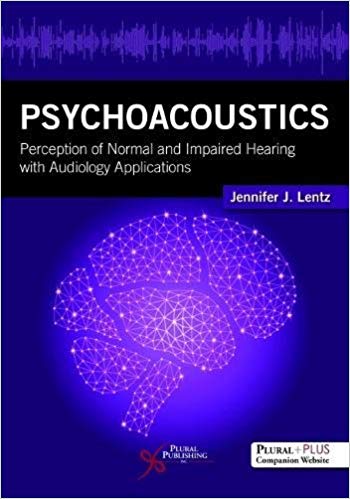Psychoacoustics: Perception of Normal and Impaired Hearing with Audiology Applications 1st Edition by Jennifer J. Lentz, ISBN-13: 978-1597569897
[PDF eBook eTextbook] – Available Instantly
- Publisher: Plural Publishing, Inc.; 1st edition (November 1, 2018)
- Language: English
- 238 pages
- ISBN-10: 1597569895
- ISBN-13: 978-1597569897
Psychoacoustics: Perception of Normal and Impaired Hearing with Audiology Applications provides an overview of the field of psychoacoustics, with a primary focus on auditory perception. The influence of hearing loss on these general auditory abilities is discussed in every chapter. Components of the book also include the role of psychoacoustics in audiological assessment and treatment. Psychoacoustics is ideal for graduate students in audiology, who intend a clinical career and need an understanding of both normal and impaired auditory perception. It is intended to give students sufficient information to understand how the ear achieves auditory perception, what the capabilities of the ear are, and how hearing loss influences that perception. It also provides students with a foundation for further study in the area and to apply psychoacoustic principles to diagnostic audiology and audiological rehabilitation.
Each chapter presents self-contained information related to the acoustics, physiology, and methodologies as they apply to the topic being discussed. Chapters include the following: introduction; relevant acoustics; important physiological studies; perception by normal-hearing listeners; and, perception by listeners who have sensorineural hearing loss. The final chapter discusses clinical implications of deficits in perceptual abilities by listeners with sensorineural hearing loss. Because psychoacoustics is intimately integrated into clinical audiology, this chapter also includes a discussion of many of the clinical tests and practices that have evolved directly from psychoacoustic experimentation.
Table of Contents:
Cover
Series Page
Title Page
Copyright
Contents
Introduction
Acknowledgments
Reviewers
1. History
Learning Objectives
Introduction
Early Investigation of Perception
The Origins of Psychoacoustics
The Advent of the Telephone
Auditory Assessment
References
2. Estimating Threshold in Quiet
Learning Objectives
Introduction
Acoustics: Pure Tones and the Decibel
Physiological Representation of Sound
Threshold of Human Hearing: MAP and MAF
Measuring the Threshold
Signal Detection Theory (SDT)
Summary and Take-Home Points
Exercises
References
3. Estimating Thresholds in Noise (Masking)
Learning Objectives
Introduction
Acoustics: Noise and Filters
Physiological Factors
Introduction to Masking
The Critical Band and the Auditory Filter
The Excitation Pattern
Psychophysical Tuning Curves and Suppression
Masking by Fluctuating Sounds
Masking and Sensorineural Hearing Loss
Clinical Implications of Masking
Summary and Take-Home Points
Exercises
References
4. Loudness and the Perception of Intensity
Learning Objectives
Introduction
Acoustics: Intensity and the Decibel
Physiological Representation of Stimulus Level
Introduction to Measuring Loudness
Loudness and Intensity
Loudness and Frequency
Calculating Loudness
Reaction Time as a Measure of Loudness
Intensity Discrimination
Effects of Sensorineural Hearing Loss on Loudness
Summary and Take-Home Points
Exercises
References
5. Temporal Processing
Learning Objectives
Introduction
Temporal Resolution: Gap Detection
Temporal Resolution: Amplitude Modulation Detection
Temporal Masking
Comparison of Temporal Processing Measures
Temporal Integration
Effects of Hearing Loss on Temporal Processing
Summary and Take-Home Points
Exercises
References
6. Pitch Perception
Learning Objectives
Introduction
Acoustics: Harmonic Complex Tones
Theories of Pitch Perception
Pitch of Pure Tones: Subjective Measures
Pitch of Pure Tones: Frequency Discrimination
Mechanisms for Coding the Pitch of Pure Tones
Pitch of Complex Sounds
Importance of Pitch Perception in Everyday Listening
Pitch Perception in Listeners with SNHL
Summary and Take-Home Points
Exercises
References
7. Hearing with Two Ears
Learning Objectives
Introduction
Binaural Advantages to Detection and Discrimination
Localization in the Horizontal Plane: Acoustics
Sound Localization in the Horizontal Plane: Physiological Basis
Sound Localization in the Horizontal Plane: Perception
Sound Localization in the Median Plane
Lateralization
Binaural Unmasking
Impact of Hearing Loss on Binaural Hearing
Summary and Take-Home Points
Exercises
References
8. Clinical Implications
Learning Objectives
Introduction
Consequences of Impaired Perception
Effects of Amplification Strategies on Perception
Influence of Psychoacoustics on Diagnostic Audiology
Summary and Take-Home Points
Exercises
References
Glossary
Index
Back Cover
What makes us different?
• Instant Download
• Always Competitive Pricing
• 100% Privacy
• FREE Sample Available
• 24-7 LIVE Customer Support






Reviews
There are no reviews yet.